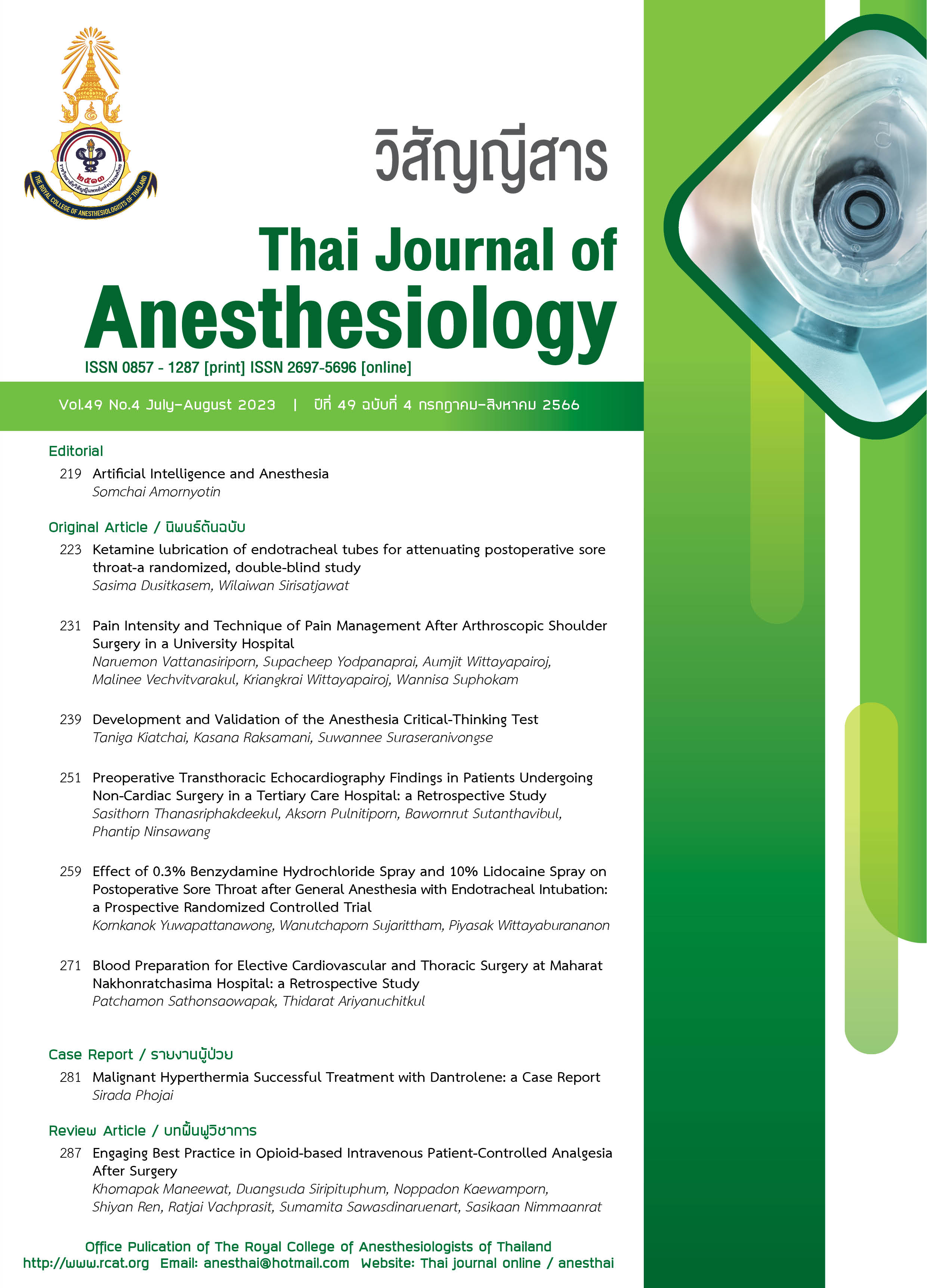Ketamine Lubrication of Endotracheal Tubes for Attenuating Postoperative Sore Throat: a Randomized, Double-Blind Study
Main Article Content
Abstract
Background: Postoperative sore throat (POST) is a common complaint after tracheal intubation for general anaesthesia, with an incidence of 32.6-57.5%. This study was designed to determine the efficacy of ketamine lubrication on the endotracheal tube cuff to reduce the incidence and severity of POST in patients undergoing general anaesthesia with endotracheal tube (ETT). Methods: This study was a prospective, randomized, double-blind study. We enrolled 40 patients who were classified as ASA I-III scheduled for surgery under general anaesthesia in this study. The participants were randomly assigned into two groups. Before induction of anaesthesia, the ETT cuff was lubricated with 1 ml (50 mg) of ketamine or 1 ml of normal saline as a control. POST was evaluated at 0, 6 and 24 h after extubation using a direct question survey with a four-point scale (0-3). Results: Data from 18 patients in the ketamine group and 18 patients in the control group were analysed. The overall incidence of POST was comparable between the ketamine group and the normal saline group (P=0.324). There was no significant difference in the incidence and severity of POST between both groups across the three intervals. No patients developed adverse effects related to ketamine administration. Conclusion: This study did not demonstrate the effect of ketamine lubrication on the ETT cuff on recuction in the incidence or severity of POST. The route of administration of ketamine may be crucial to its effectiveness in attenuating the incidence and severity of POST.
Article Details

This work is licensed under a Creative Commons Attribution-NonCommercial-NoDerivatives 4.0 International License.
References
Lee JY, Sim WS, Kim ES, et al. Incidence and risk factors of postoperative sore throat after endo-tracheal intubation in Korean patients. J Int Med Res. 2017;45:744-52.
Biro P, Seifert B, Pasch T. Complaints of sore throat after tracheal intubation: a prospective evaluation. Eur J Anaesthesiol. 2005;22:307-11.
El-Boghdadly K, Bailey CR, Wiles MD. Postoperative sore throat: a systematic review. Anaesthesia. 2016;71:706-17.
McHardy FE, Chung F. Postoperative sore throat: cause, prevention and treatment. Anaesthesia. 1999;54:444-53.
Singh NP, Makkar JK, Cappellani RB, Sinha A, Lakshminarasimhachar A, Singh PM. Efficacy of topical agents for prevention of postoperative sore throat after single lumen tracheal intubation: a Bayesian network meta-analysis. Can J Anaesth. 2020;67:1624-42.
Sawynok J. Topical and peripheral ketamine as an analgesic. Anesth Analg. 2014;119:170-8.
Slatkin NE, Rhiner M. Topical ketamine in the treatment of mucositis pain. Pain Med. 2003;4:298-303.
Rudra A, Ray S, Chatterjee S, Ahmed A, Ghosh S. Gargling with ketamine attenuates the postoperative sore throat. Indian J Anaesth. 2009;53:40-3.
Mayhood J, Cress K. Effectiveness of ketamine gargle in reducing postoperative sore throat in patients undergoing airway instrumentation: a systematic review. JBI Database System Rev Implement Rep. 2015;13:244-78.
Kuriyama A, Nakanishi M, Kamei J, Sun R, Ninomiya K, Hino M. Topical application of ketamine to prevent postoperative sore throat in adults: a systematic review and meta-analysis. Acta Anaesthesiol Scand. 2020;64:579-91.
Marland S, Ellerton J, Andolfatto G, et al. Ketamine: use in anesthesia. CNS Neurosci Ther. 2013;19:381-9.
Kim E, Yang SM, Yoon SJ, Bahk JH, Seo JH. The effects of water lubrication of tracheal tubes on post-intubation airway complications: study protocol for a randomized controlled trial. Trials. 2016;17:562.
Blunt MC, Young PJ, Patil A, Haddock A. Gel lubrication of the tracheal tube cuff reduces pulmonary aspiration. Anesthesiology. 2001;95:377-81.
Wang G, Qi Y, Wu L, Jiang G. Comparative efficacy of 6 topical pharmacological agents for preventive interventions of postoperative sore throat after tracheal intubation: a systematic review and network meta-analysis. Anesth Analg. 2021;133:58-67.
Domino KB, Posner KL, Caplan RA, Cheney FW. Airway injury during anesthesia: a closed claims analysis. Anesthesiology. 1999;91:1703-11.
Parkes AW, Harper N, Herwadkar A, Pumphrey R. Anaphylaxis to the chlorhexidine component of Instillagel®: a case series. Br J Anaesth. 2009;102:65-8.
Lee J, Lee YC, Son JD, Lee JY, Kim HC. The effect of lidocaine jelly on a taper-shaped cuff of an endotracheal tube on the postoperative sore throat: a prospective randomized study: a CONSORT compliant article. Medicine. 2017;96:e8094.
Reddy M, Fiaz S. Dose-dependent effectiveness of ketamine nebulisation in preventing post-operative sore throat due to tracheal intubation. Sri Lankan J Anaesthesiol. 2018;26:22-7.
Jonkman K, Duma A, Olofsen E, et al. Pharma-cokinetics and bioavailability of inhaled esketa-mine in healthy volunteers. Anesthesiology. 2017;127:675-83.
Henthorn TK, Krejcie TC, Niemann CU, Enders-Klein C, Shanks CA, Avram MJ. Ketamine distribution described by a recirculatory pharmacokinetic model is not stereoselective. Anesthesiology. 1999;91:1733-43.
Monroe MC, Gravenstein N, Saga-Rumley S. Postoperative sore throat: effect of oropharyngeal airway in orotracheally intubated patients. Anesth Analg. 1990;70:512-6.
Shrestha S, Maharjan B, Karmacharya RM. Incidence and associated risk factors of postoperative sore throat in tertiary care hospital. Kathmandu Univ Med J. 2017;15:10-3.


